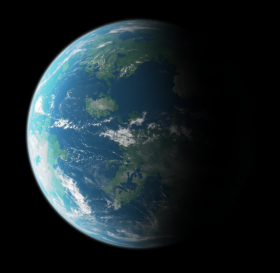Difference between revisions of "Sahar"
Jump to navigation
Jump to search
m |
m |
||
| (13 intermediate revisions by 5 users not shown) | |||
| Line 1: | Line 1: | ||
{{construction}} | {{construction}} | ||
{{Infobox planet | {{Infobox planet | ||
| name = Sahar | | name = Sahar | ||
| symbol = | | symbol = | ||
| image = | | image = Screen Shot 2017-08-27 at 11.04.38 PM.png | ||
| image_size = 280px | |||
| caption = Sahar as seen from space. | | caption = Sahar as seen from space. | ||
| discovery = no | | discovery = no | ||
| Line 22: | Line 23: | ||
| asc_node = -11.260 64 deg to J2000 ecliptic | | asc_node = -11.260 64 deg to J2000 ecliptic | ||
| arg_peri = 114.207 83 deg | | arg_peri = 114.207 83 deg | ||
| satellites = | | satellites = One natural satellite: [[Kun]] | ||
| allsatellites = yes | | allsatellites = yes | ||
| physical_characteristics = yes | | physical_characteristics = yes | ||
| Line 76: | Line 74: | ||
}} | }} | ||
'''Sahar''' | '''Sahar''' is the second planet from [[Harkis]] and the only planet known to harbor life. It is the densest planet in the [[Harkis system]] and the largest of the three terrestrial planets. | ||
{{Harkis System}} | |||
[[Category:Sahar]] | [[Category:Sahar]] | ||
[[Category:Geography]] | |||
[[Category:Planets of the Harkis System]] | |||
Latest revision as of 19:16, 13 July 2021
This article or section is undergoing expansion or major restructuring. You are welcome to assist in its construction by editing it as well.
This article was last edited by Jute (talk | contribs) 2 years ago. (Update) |
 Sahar as seen from space. | |||||||||||||
| Orbital characteristics | |||||||||||||
|---|---|---|---|---|---|---|---|---|---|---|---|---|---|
| Epoch J2000 | |||||||||||||
| Aphelion | 152 100 000 km (1.016 73 AU) | ||||||||||||
| Perihelion | 147 095 000 km (0.983 2687 AU | ||||||||||||
| 149 598 023 km (1.000 001 018 AU | |||||||||||||
| Eccentricity | 0.016 7086 | ||||||||||||
| 365.256 363 004 days (1.000 017 420 96 yr) | |||||||||||||
Average orbital speed | 29.78 km/s (107 200 km/h) | ||||||||||||
| 358.617 deg | |||||||||||||
| Inclination | 7.155 deg to Sun's equator; 1.57869 deg to invariable plane; 0.00005 deg to J2000 ecliptic | ||||||||||||
| -11.260 64 deg to J2000 ecliptic | |||||||||||||
| 114.207 83 deg | |||||||||||||
| Satellites | One natural satellite: Kun | ||||||||||||
| Physical characteristics | |||||||||||||
Mean radius | 6 371.0 km | ||||||||||||
Equatorial radius | 6 378.1 km | ||||||||||||
Polar radius | 6 356.8 km | ||||||||||||
| Flattening | 0.003 3528 1/298.257222101 | ||||||||||||
| Circumference |
| ||||||||||||
| |||||||||||||
| Volume | 1.083 21 × 10^12 km3 | ||||||||||||
| Mass | 5.972 37 x 10^24 kg
(3.0 x 10^-6 solar mass) | ||||||||||||
Mean density | 5.514 g/cm3 | ||||||||||||
| 9.807 m/s2 g | |||||||||||||
| 0.3307 | |||||||||||||
| 11.186 km/s | |||||||||||||
Sidereal rotation period | 0.997 269 68 d (23h 56m 4.100s) | ||||||||||||
Wikipedia:Equatorial rotation velocity | 1674.4 km/h (465.1 m/s) | ||||||||||||
| 23.439811° | |||||||||||||
| Albedo | 0.367 geometric 0.306 Bond | ||||||||||||
| |||||||||||||
| Atmosphere | |||||||||||||
Surface pressure | 101.325 kPa (at MSL) | ||||||||||||
| Composition by volume |
| ||||||||||||
Sahar is the second planet from Harkis and the only planet known to harbor life. It is the densest planet in the Harkis system and the largest of the three terrestrial planets.